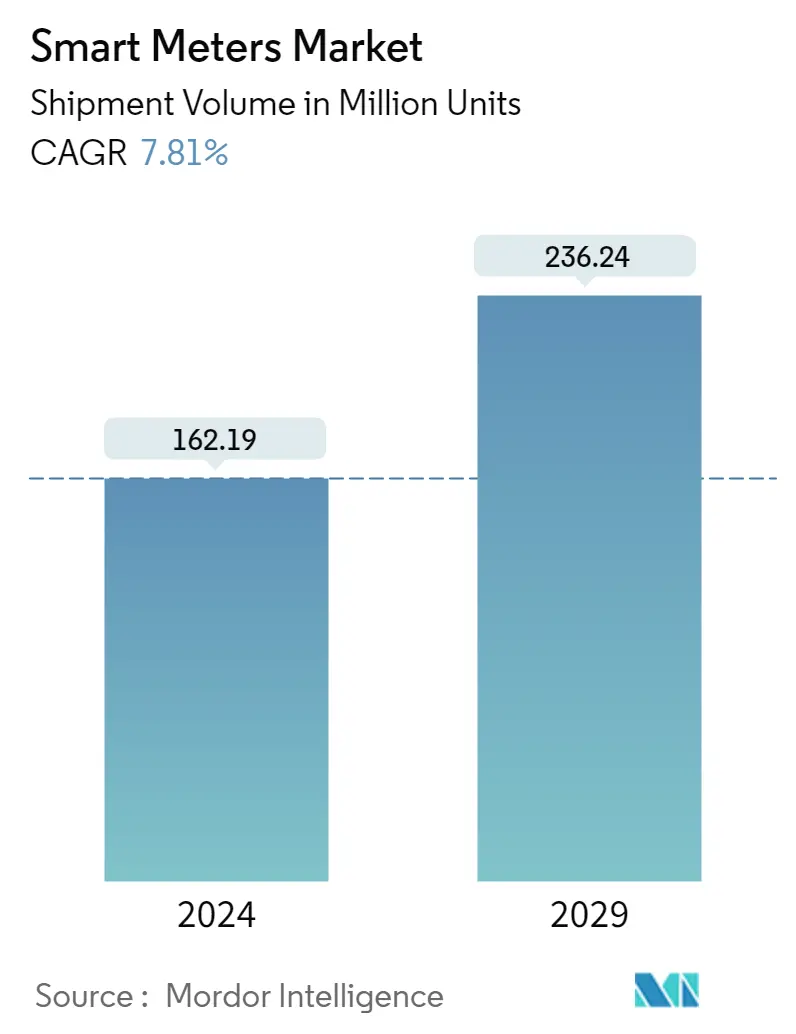Market Size of Smart Meters Industry

| Study Period | 2019 - 2029 |
| Market Volume (2024) | 162.19 Million units |
| Market Volume (2029) | 236.24 Million units |
| CAGR (2024 - 2029) | 7.81 % |
| Fastest Growing Market | Asia Pacific |
| Largest Market | Asia Pacific |
Major Players
*Disclaimer: Major Players sorted in no particular order |
Need a report that reflects how COVID-19 has impacted this market and its growth?
Smart Meters Market Analysis
The Smart Meters Market size in terms of shipment volume is expected to grow from 162.19 Million units in 2024 to 236.24 Million units by 2029, at a CAGR of 7.81% during the forecast period (2024-2029).
In order to increase the effectiveness of electrical networks, smart grids are being introduced all over the world. As a result, smart grids, which include smart electricity meters, are being deployed globally. To combat the negative impacts of pollution on the environment, nations all over the world are enacting emission control rules. This is the main factor driving the market.
- Due to their two-way communication capability, smart meters are being adopted more widely across the globe for various deployments, including electricity, gas, and water. This feature allows both utility suppliers and consumers to track utility usage in real-time and encourages suppliers to start, read, or cut off supply remotely.
- Consumer electronics, office equipment, and other plug loads consume nearly 15% to 20% of the total residential and commercial electricity while not in the primary mode. Most of this energy is consumed when they operate in low-power modes (even while they are not in use). Consumers are increasingly tending to install a smart energy management system to track such scenarios.
- Smart meters deployment also enables the implementation of a Home Energy Management System (HEMS) or Building Energy Management System (BEMS) that allows visualization of the electric power usage in individual homes or entire buildings.
- Further, digitization is accelerating and modernizing energy efficiency measures, due to which the deployment of smart grids is increasing globally, as they are capable of dynamically optimizing supply and fostering supply of large amounts of electricity from renewable energy sources such as solar power.
- Moreover, increasing government support and investments are expected to boost smart meters adoption and deployment in the country. For instance, India's state-owned Energy Efficiency Services Limited (EESL) completed the installation of approximately 10 lakh smart meters across India under the Government of India's Smart Meter National Programme. EESL set the target to install 25 crore smart meters over the next few years. Also, the need to establish a manufacturing base of smart electricity meters in the country to ensure an adequate supply of an adequate number of meters to be installed all over the country, by ruling out monopoly, is expected to act as a major driver.
- Lockdowns caused by the global COVID-19 epidemic caused a number of operations in many industries to come to a standstill. As a result, there was a decline in smart meter shipments and installations.
- However, as the COVID-19 requirements are gradually relaxed, it is anticipated that over time, the installation of smart meters will rise as well. The majority of energy providers are easily encouraging their consumers to update to smart meters in many developed locations.
